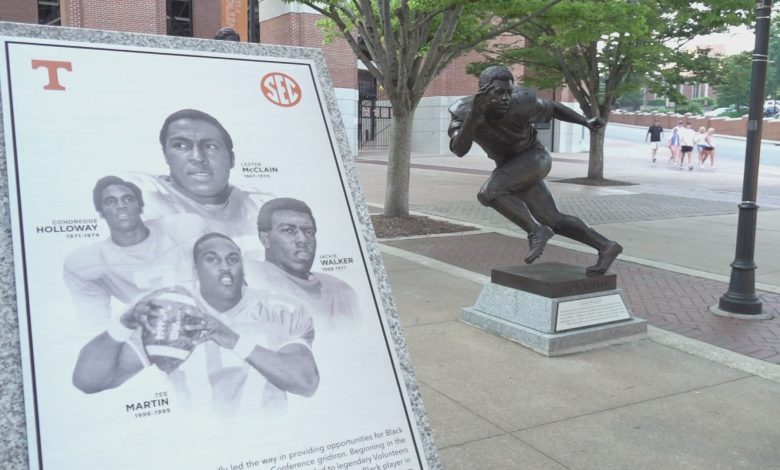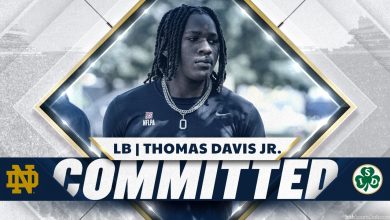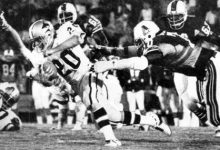Bob Johnson Center (1965-67) left UT as one of the most decorated athletes in school history. Doug Dickey’s first recruit struggled making snaps his sophomore year after moving over from the tackle position, but rebounded to garner All-America status in 1966.

Before Peyton Manning rewrote passing records and before Reggie White terrorized quarterbacks, Tennessee football was defined by a lineman whose strength, intelligence, and resilience made him one of the most decorated players in program history. Bob Johnson, who played center for the Vols from 1965 to 1967, left the University of Tennessee as an icon of consistency and leadership—a foundational figure in the modern era of Volunteer football.
A product of Cleveland, Ohio, Johnson was the first player ever recruited by legendary head coach Doug Dickey, making his journey symbolic of Tennessee’s transformation during the 1960s from a struggling program to a rising national power. Over the course of his career, Johnson didn’t just anchor the offensive line—he became its beating heart.
Though he would go on to become a consensus All-American at center, Johnson began his college career as a tackle, a position he had played in high school. But upon arrival in Knoxville, Dickey saw in him the potential for something greater at the center position.
That shift, however, did not come without its growing pains.
As a sophomore in 1965—his first year as a starter after freshmen were ineligible to play varsity—Johnson struggled with the mechanics of snapping the football and adapting to the mental demands of his new role. Bad snaps and communication issues were frequent, drawing the attention of fans and coaches alike.
But instead of crumbling under the pressure, Johnson worked tirelessly to improve his technique. He devoted hours to film study and developed a sharp understanding of blocking schemes and defensive alignments. By the time the 1966 season arrived, he had fully embraced his position—and soon emerged as one of the best centers in the country.
“I learned that if you wanted to lead, you had to take the hits, take the blame, and keep going,” Johnson later recalled. “That sophomore year made me tougher.”
Bob Johnson’s rapid rise coincided with Tennessee’s resurgence under Dickey, who took over a program in disarray and transformed it into a perennial SEC contender. With Johnson calling protections and leading the line, Tennessee’s offense grew sharper, more balanced, and far more dangerous.
By 1966, the Vols had begun to reassert themselves on the national stage, going 8–3 and earning a Gator Bowl berth. Johnson’s performance at center was instrumental—not only in Tennessee’s execution on the field, but in setting the tone for toughness and accountability within the locker room.
That year, Johnson earned All-America honors, becoming one of the nation’s most respected linemen. His blend of size, strength, and sharp football IQ turned him into a coach on the field—a rare combination at any position, but especially crucial at center.
In 1967, Johnson repeated as an All-American and became a finalist for the Outland Trophy, awarded to the nation’s top interior lineman. The Vols finished 9–2 and played in the Orange Bowl, solidifying their return to national relevance.
Bob Johnson’s importance to Tennessee went far beyond physical ability. Coaches and teammates consistently referred to him as the team’s emotional and strategic center—calm under pressure, unflinching in adversity, and quietly dominant on the field.
He started every game of his collegiate career, never missing a start from 1965 through 1967. That durability became part of his legend.
Known for his low pad level, crisp handwork, and unrelenting drive, Johnson was so dependable that many Vols fans of the era joked that the only time his name was called during a broadcast was when he made a perfect downfield block—or when his helmet popped off in a collision.
“He wasn’t flashy,” former teammate Walter Chadwick said. “But if you watched the tape, Bob Johnson won every single snap.”
In an era before centers were celebrated as stars, Johnson changed the perception of the position—not just at Tennessee, but across the Southeastern Conference.
Bob Johnson’s dominance didn’t go unnoticed at the next level. In the 1968 NFL Draft, held shortly after the AFL-NFL merger agreement, Johnson was selected No. 2 overall by the Cincinnati Bengals, making him the first-ever draft pick in franchise history.
He remains one of only a handful of centers to ever be drafted in the top five—and the only center ever chosen as a team’s inaugural draft pick.
Playing under head coach Paul Brown, Johnson went on to have a successful 12-year career with the Bengals, serving as their starting center from 1968 until his retirement in 1979. He was named an AFL All-Star, played in over 150 games, and was twice named team captain.
Perhaps most telling of his character, when the Bengals retired his jersey number (54), the gesture came not only because of his play—but because of his influence in shaping the culture and professionalism of a new franchise.
“Bob was everything we wanted this organization to stand for,” Paul Brown once said. “He was our cornerstone.”
Bob Johnson’s place in Tennessee football history is secure. He was inducted into the College Football Hall of Fame in 1989, joining the ranks of the sport’s most legendary figures.
His No. 55 jersey (which he wore at Tennessee) is retired, one of only a few numbers to receive that honor in Knoxville. He was also named to Tennessee’s All-Century Team and included on several lists of the greatest SEC players of all time.
In the years since his playing days, Johnson has remained active with the university, serving on advisory boards and mentoring student-athletes. His humility, intelligence, and example continue to serve as a model for what Tennessee asks of its players—on the field, in the classroom, and in life.
Johnson’s career coincided with a critical turning point in Tennessee football. He arrived when the program was searching for a new identity, and by the time he left, the Volunteers were SEC contenders once again. More than perhaps any other player, Bob Johnson embodied the grit, stability, and quiet excellence that fueled that rise.
He helped change how the center position was viewed—not just as a blocker, but as a field general, communicator, and difference-maker. In doing so, he laid the groundwork for generations of Tennessee linemen to come.
And just as important, he helped Doug Dickey set the tone for a new era of Volunteer football. As Dickey himself once said:
“If you want to understand what we were trying to build at Tennessee in the 1960s, look at Bob Johnson. He was the foundation.”
Bob Johnson may never have chased headlines or spotlight. He didn’t need to. He simply showed up, played at an elite level, and led by example. In doing so, he carved out a legacy as one of the most important—and most decorated—players in the history of Tennessee football.
He wasn’t just a center.
He was the center—in every possible way.
And as the years pass, his name remains etched in Tennessee lore not only for the awards he won, but for the excellence, steadiness, and leadership he embodied from the very first snap.








